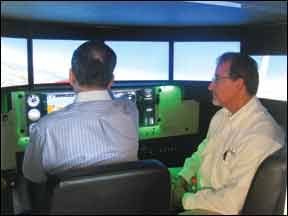In 2007, Redbird Flight Simulations had a prototype flight simulator that basically consisted of Microsoft Flight Simulator on several screens and a moving cockpit enclosure. We flew it for two minutes before it broke.
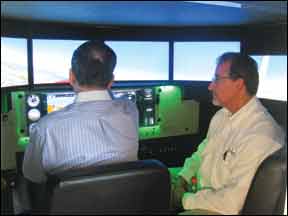
Things have improved since then. Today the company ships better than one a simulator a day, if you count both their tabletop version and full-motion enclosures. Most are reconfigurable, GA sims, but they also build custom simulators for specific aircraft such as the King Air C90. With over 430 units in the field now (223 full-motion), Redbird is the largest simulator company in the world in terms of devices sold.
The Glass-Panel Problem
A major factor in Redbird’s success has been cost, and a big influence on simulator cast has been the transition to glass cockpits in GA. The issue is that to put a G1000 or Avidyne system into a simulator requires either putting in at least some of the real avionics, which skyrockets the price, or reverse engineering the glass panel to get something functionally close enough that it’s a seamless transition when the student moves to the real cockpit.
Most simulator companies took the first route. Redbird was founded by a bunch of ex-Dell Computer executives who were used to turning off-the-shelf parts into competitive products. They took on the second route and recreated the G1000, the Avidyne Entegra and the ubiquitous Garmin GNS 430/530 down to every button and knob. (They even reverse engineered a Pro Line 21 suite for the C90 King Air sim.)
This created a huge price gap between Redbird and the competition. A typical tabletop simulator that uses real G1000 parts costs in the $80,000 range. Redbird’s TD models of tabletop simulators cost about $8000. Furthermore, real G1000 parts can only simulate one model of aircraft. If you buy a setup for a Cessna 182T, it can’t simulate a Cessna 172S, let alone a Diamond DA40. The Redbirds have interchangeable bezels, so one TD unit could be bought with bezels to simulate G1000, Avidyne and a traditional six-pack with a pair of GNS 430s.
Stepping up the chain, a traditional simulator for something like a Cirrus SR22 with a 120-degree wrap-around screen and full cockpit would set a school back $250,000. The Redbird FMX models, which have full motion but visuals displayed on several off-the-shelf LCD screens, cost in the $80,000 range. They also fit in a much smaller space because they don’t rely on the cinematic experience. The TD and FMX are the two ends of the product line. There are non-motion enclosure models in between.
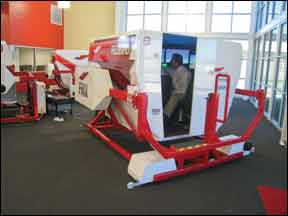
The downside here is that a Redbird is close to the real G1000 screens and buttons, but not exactly the same. The cockpits contain all the needed buttons and switches, but they aren’t full fidelity to the real aircraft. Visuals on several LCD monitors are arguably less realistic than a wrap-around display. Argument, as it turns out, was the genesis for Redbird’s next step.
Sim-Centered Training
“We’ve had a long-standing argument with the FAA that the highest certification we can get is AATD,” says Jerry Gregoire, president of Redbird. But he also told us, “It’ll probably be incumbent on all of us not to worry about the FAA’s point of view. Certifications are not going to be able to keep up with realism or utility.”
The problem is that Redbird’s systems don’t fit neatly into the current FAA classification of simulators and training devices. As an Advanced Aviation Training Device (AATD), the full-motion FMX can count toward 20 hours of instrument training and 50 hours of time toward a commercial rating, but only 2.5 hours of training toward a private pilot certificate.
“I couldn’t care less what they credit,” says Roger Sharp, GM for flight operations at Redbird. “We’re teaching the motor skills and the tasks.” What flight schools are finding is that even though a student pilot may not be able to log over 2.5 hours in the sim, time spent there is reducing the total airplane time the student needs to pass the practical test. But the evidence for this is all anecdotal. Redbird has set up its own flight school in San Marcos, Texas to test it.
The Redbird Skyport is both FBO and Part 141 flight school that’s offering a flat-fee $9500, three-week private pilot certificate using the sims and new Cessna 172s. The curriculum is being developed with King Schools, but the core difference is that everything happens in the simulator first.
Gregoire describes the simulator as a “training delivery system,” meaning that it’s more than just a representation of the airplane used with a live instructor. A typical lesson would have the student at the sim watch a video of the maneuver to be learned or scenario to be flown on the screen. Then the sim would put the student in exactly that spot to try what they just saw. The sim could evaluate the performance and even show the appropriate clip with suggestions on how to improve areas that scored low.
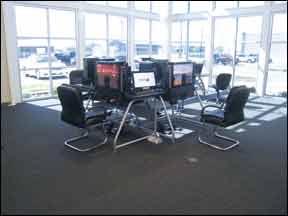
While there’s no CFI in that scenario, there would be instructor-guided lessons as well. When the skill is mastered in the sim, it would be time for the real airplane. The idea isn’t so much to replace airplane time with sim time, so much as to get prepare students for the real airplane and get their ticket in the minimum real-airplane time. Redbird has scored a bit of a coup on that minimum time, too. At their school, there isn’t any minimum.
Sharp won a special approval for flight-test eligibility based solely on student proficiency. Theoretically a student with five hours of real airplane time could take and pass a checkride. But that’s not likely. “I think we’ll be around the 30-hour mark in the airplane,” says Sharp. “But we don’t know that until we put a statistically significant number through the program.”
As you read this, the first eight students are just finishing their three-week training course. Sharp hopes that by mid 2012 he’ll have some reliable data on how we’ll this is happening. These won’t be just private pilots, either. The full Redbird program is through Commercial pilot and CFI, single- and multi-engine land.
A key part of the program is that students will always have a lesson, even if the aircraft is down or the weather is unflyable. The theory is that this will keep students both on course for completing their training on time and engaged in the flight training process (not to mention a steady revenue stream for the flight school). That said, Redbird Skyport students can use the simulators solo all they want for no extra cost.
The Skyport is being touted as a laboratory, with all the data they generate on simulator impact being available to the industry.
Beyond Motion
As might be expected from a bunch of ex-computer execs, there are additional high-tech projects in the mix. Each student gets a USB stick with their training information on it. They can plug that into any sim and pick up their training right where they left off.
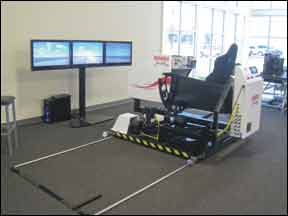
Redbird is developing a system called Parrot to train students to talk on the radio. This is a fully automated ATC that takes requests and gives clearances for taxi, takeoff and landing. If the student gets the standard phraseology within specs, the clearance is given. If they don’t do it right, they’ll get some guidance to try it again.
Redbird purchased a product called the X-wind trainer and has developed it further. This isn’t so much a sim as a procedures trainer. The cockpit banks, yaws and slides physically left and right while a runway draws nearer on three distant screens. The pilot is graded on both crab angle on touchdown and distance from the centerline. Hitting zero on both counts would be a perfect score.
It’s harder than you might think. We tried the X-wind with the crosswind and turbulence dialed up and the only thing pretty about the landing was that it was pretty survivable. In an effort to save some face, we pointed out that the trainer had no option to go around. This could have the negative impact of teaching students that every crosswind landing should be run all the way through. But that’s what the laboratory is all about: testing these outcomes. (Future X-winds might get a big go-around button.)
Experiment in Progress
As promising as all this looks, the only thing Redbird has proven so far is there’s a real market for lower-cost simulators. Real evidence of the impact of these sims, particularly outside the realm of instrument training, is yet to be shown quantitatively. The sims themselves are still evolving as well. The visuals are still generated by Microsoft Flight Simulator X under an agreement with Microsoft, but a more capable simulation platform will replace it.
Redbird plans to offer their sim-centered training program to other flight schools to adapt to their own situations. We’ve also heard that schools have inquired about setting up their own Skyports in other parts of the country.
The future as Gregoire sees it includes an even greater expansion of what simulation and computer mentorship can do. The next stage would be having the simulator monitor the student’s performance flying a scenario and introducing conditions on the fly that force the student to practice their personal weak spots. The future could even include bringing the intelligence of a simulator system into the real airplane as a mentor, even after training is complete.
Of course, by the third time it points out you rotated late on a takeoff, you might find yourself searching for a way to make it break. Technology needs to have some limits.

